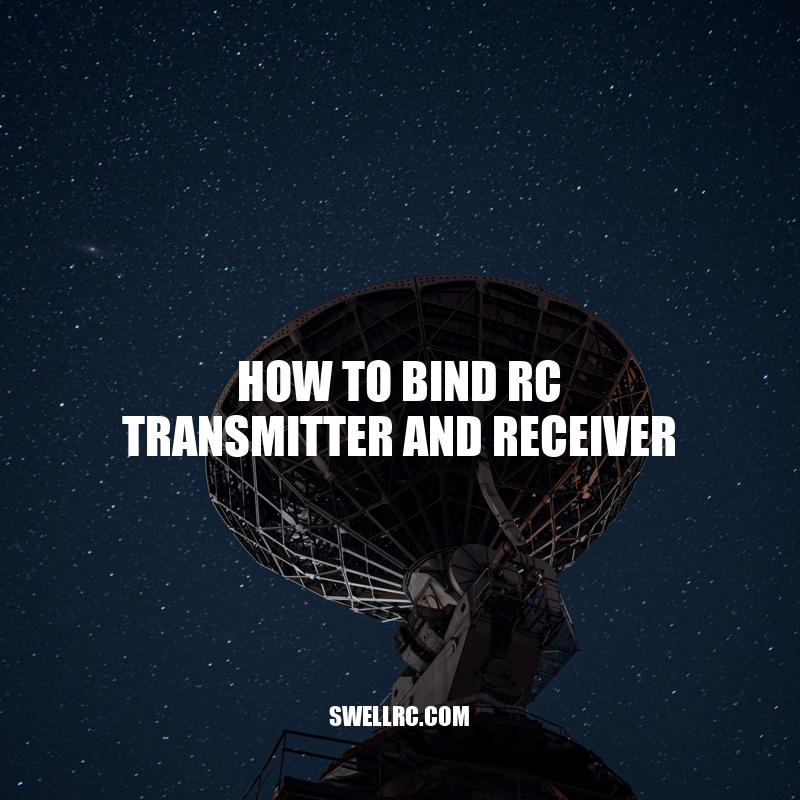How to Bind RC Transmitter and Receiver: A Step-by-Step Guide
If you are new to the world of remote control (RC) vehicles, one of the most important things you need to know is how to bind your transmitter to the receiver. The process of binding is necessary to establish a secure and stable connection between the transmitter and the receiver, which enables them to communicate with each other. Without this crucial step, you will not be able to control your RC vehicle effectively, which can lead to accidents, crashes, or loss of your RC model. Knowing how to bind your RC transmitter and receiver is an essential skill that all RC enthusiasts must master. In this guide, we will show you how to bind your RC transmitter and receiver, step-by-step, so you can enjoy a smooth and safe RC experience. Whether you are using a car, plane, helicopter or any other RC model, this guide will help you bind your RC transmitter and receiver with ease.
Choosing The Right Components
Before binding your RC transmitter and receiver, it’s crucial to ensure that you are using the right components. Here are some factors to consider when choosing your RC components:
- Compatibility: Make sure that the transmitter and receiver are compatible with each other. Refer to the manufacturer’s specifications to ensure this.
- Frequency Range: Choose a transmitter and receiver that are on the same frequency range. Mixing up different frequency ranges can lead to transmission interferences and glitches.
- Number of Channels: The number of channels will determine the number of control functions you can operate on your RC model. Make sure your transmitter has enough channels to handle your model’s functions.
Some popular brands of RC transmitters and receivers include Futaba, Spektrum, FrSky Taranis, FlySky, and Traxxas. You can find a wide range of RC components on online stores such as Amazon, eBay, or hobby-specific websites like RC Planet or Tower Hobbies. Once you have the right components, you can start preparing for the binding process.
Preparing For The Bind Process
Before binding your RC transmitter and receiver, there are a few preparation steps you need to take:
- Charge your batteries: Ensure your transmitter and receiver batteries are fully charged to avoid any hiccups during the binding process.
- Remove any servo connectors: Unplug any servo connectors between the receiver and servos so that you can bind the receiver without sending control signals to the servos.
- Power on the transmitter: Turn on your transmitter while holding down the bind button. Refer to the user manual to locate the specific button for your transmitter.
It’s important to note that some transmitters may not have a built-in bind button. In this case, you can use an external bind plug or refer to the instructions manual for your specific transmitter.
Binding Compatibility Table
To help you choose compatible bind modes for your RC transmitter and receiver, refer to the table below:
| Transmitter Brand/Model | Compatible Receiver Bind Modes |
|---|---|
| Futaba 2.4GHz FASST / FHSS | Futaba FHSS and S-FHSS |
| Spektrum DSM2 / DSMX | Spektrum DSMX and DSM2 |
| FrSky Taranis | FrSky D8, Futaba S-FHSS, Spektrum DSM2, and DSMX |
| FlySky | FlySky AFHDS and AFHDS 2A |
| Traxxas TQi | Traxxas TQi |
Once you’ve prepared your components for binding, you can follow the next steps of the process to start controlling your RC model.
How do you bind a transmitter to an RC car?
To bind a transmitter to an RC car, follow these simple steps:
- Ensure the transmitter and receiver are compatible and on the same frequency.
- Turn off both the transmitter and the RC car.
- Put the transmitter in the bind mode or pair mode.
- Turn on the RC car.
- The receiver should now be properly bound to the transmitter.
For more in-depth guidance, consult your RC car’s manual or check the manufacturer’s website. Additionally, Youtube and other online forums are great resources for more detailed instructions and troubleshooting tips.
Binding The Receiver
After preparing the components, the next step is to bind your RC receiver to your transmitter. The basic steps for most systems include:
- Put the receiver in binding mode: Press and hold the binding button or plug in the binding plug while powering up the receiver. Refer to the user manual for your specific receiver on how to enable binding mode.
- Initiate binding mode on the transmitter: While in binding mode, turn on the transmitter holding down the bind button or following the specific instructions for your transmitter.
- Verify successful binding: Once the binding process is complete, the LED on both the transmitter and receiver should stop flashing, indicating that they have successfully connected.
- Calibrate the servos: At this point, you can proceed to check and adjust the servo endpoints and trims to get them to work at their optimal levels.
It is important to remember that the binding process may differ depending on the specific system you’re working with, so it’s always best to refer to the manufacturer’s instructions.
When looking for a reliable and efficient RC transmitter and receiver system, some of the most popular brands include FrSky, Spektrum, Tactic, Futaba, and FlySky. These brands offer a range of transmitters and receivers with different features and specifications, and you can choose based on your particular needs. Additionally, many online hobby shops offer a wide range of RC transmitter and receiver systems at an affordable price, such as Tower Hobbies, Horizon Hobby, and Amazon.
Can I use any RC receiver with my transmitter?
No, you cannot use any RC receiver with your transmitter as each transmitter is designed to work with a specific type of receiver. Using a mismatched receiver can result in poor performance or complete malfunction of your RC system. It’s important to use the compatible receiver specified by the manufacturer of your transmitter in order to ensure the best performance and reliability.
- If you’re unsure about which receiver to use with your transmitter, you can always check the manufacturer’s website or manual for more information.
- You can also find compatible receivers for your transmitter at hobby and RC stores, as well as online retailers such as Amazon and eBay.
Testing And Calibrating
After binding, it’s important to test and calibrate the servos for accurate control of the aircraft or vehicle. Here are the steps to follow:
- Test the controls: Activate each control and observe whether it moves in the desired direction.
- Adjust the endpoints: If the servos do not move the control surfaces through their full range, adjust the endpoints to increase or decrease the limits of the servo travel.
- Trim: Adjust the trim tabs to fine-tune the control surfaces.
- Check the fail-safe: Set the fail-safe on the receiver to ensure that the servos return to a safe position in case the transmitter signal is lost.
It’s worth noting that the calibration process may vary depending on the type and manufacturer of the transmitter and receiver. If you encounter any issues, always refer to the user manual.
When it comes to testing and calibrating your RC transmitter and receiver system, there are a few tools you may find helpful, including:
- Servo tester: This device allows you to test your servos without having to connect them to the receiver, making it easier to check the endpoints and movements of each individual servo.
- Voltmeter: A voltmeter is useful for checking the voltage of the receiver and ensuring that it is within the acceptable range.
- USB simulator: A USB simulator allows you to practice flying your RC aircraft or vehicle on your computer before taking it out for a real-world test.
RC hobby shops and online retailers such as Tower Hobbies, Banggood, and Amazon offer a range of tools and accessories for RC enthusiasts.
How do you calibrate a RC transmitter?
Calibrating a RC (Radio Control) transmitter is a necessary process before you can fly your drone or remote-controlled vehicle. Here are the steps to follow:
- Turn on your RC transmitter and your aircraft or vehicle.
- Move all the sticks and switches on the transmitter to their extremes and hold them there.
- Go to the calibration settings on your device and follow the on-screen instructions to calibrate the sensors.
- Once the calibration is complete, test the controls to ensure they are working as intended.
For more detailed instructions, check out the user manual for your RC transmitter and aircraft or vehicle.
If you are looking for products that can help you with calibrating your RC transmitter, consider checking out websites such as RC Geeks or Horizon Hobby.
Additional Considerations
Depending on the specific components being used, there may be additional considerations you need to keep in mind when binding your RC transmitter and receiver. Here are some examples:
Telemetry
Some RC transmitters and receivers are equipped with telemetry capabilities, which allow you to monitor various aspects of your RC aircraft or vehicle in real-time, such as the battery voltage, altitude, and temperature. When binding components with telemetry capabilities, you may need to follow additional steps, such as assigning channels for telemetry data and setting up alarms for specific thresholds.
Binding Multiple Receivers
In some cases, you may need to use multiple receivers for your RC aircraft or vehicle, such as when using a distributed power system or when controlling multiple control surfaces. Binding multiple receivers can be a bit more complicated than binding a single one, and you may need to follow specific instructions provided by the manufacturer.
Compatibility
While most RC transmitters and receivers use similar binding processes, there may be some compatibility issues between different brands or models, especially if they use proprietary protocols. Before purchasing new components, make sure to check their compatibility with your existing setup.
When it comes to buying RC components and accessories online, there are many websites and marketplaces to choose from. Here are a few that you may find useful:
- Tower Hobbies: One of the largest online retailers of RC products, with a wide selection of aircraft, vehicles, parts, and accessories.
- Banggood: A Chinese e-commerce website offering a variety of RC products and electronics at competitive prices. Shipping times may vary.
- Amazon: The world’s largest online marketplace, with a wide range of RC products and accessories from various brands and sellers.
Can you pair any RC transmitter with any receiver?
- No, you cannot pair any RC transmitter with any receiver as they operate on different frequencies and protocols.
- It is important to check the compatible frequency and protocol of the transmitter and receiver before purchasing them.
- Most manufacturers provide information on compatible transmitters and receivers on their website or product manual.
Checking for compatibility can ensure a smooth and stable connection between your RC transmitter and receiver.
Conclusion
Binding your RC transmitter and receiver is an essential step in setting up your RC aircraft or vehicle, and following the correct procedure is crucial for ensuring accurate, responsive control. By carefully selecting compatible components, preparing them for binding, following the manufacturer’s instructions, and testing and calibrating them, you can successfully bind your RC equipment and enjoy your hobby with confidence.
Remember to keep in mind the specific considerations for your components, and don’t hesitate to seek help or guidance if you encounter any issues. With the right knowledge and resources, binding your RC transmitter and receiver can be a straightforward process that leads to hours of fun and excitement.
As you search for more information on RC transmitter and receiver binding, you may find various online resources, forums, and communities that offer helpful tips and insights. You can also check the websites and marketplaces mentioned in this article for purchasing components and accessories.
Binding RC transmitters and receivers can be complicated for beginners, that’s why this guide aims to provide an easy-to-follow, step-by-step procedure. Remember to stay alert and be careful throughout the process. Now, go ahead and enjoy your RC toys!



